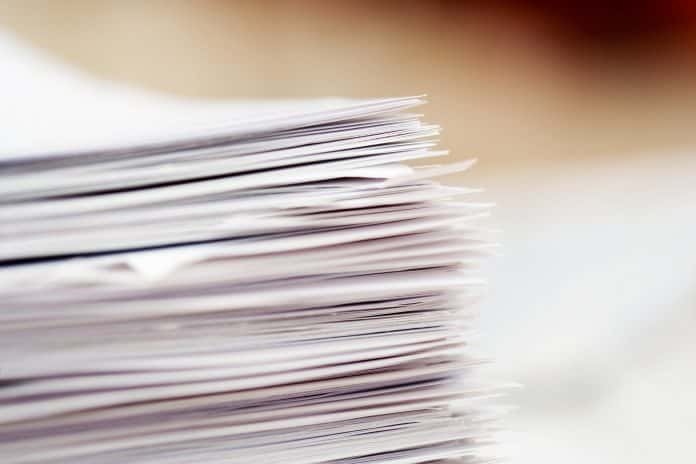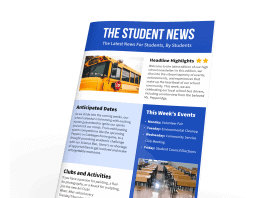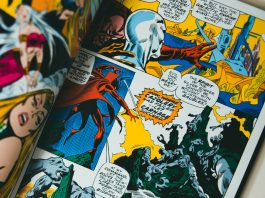Last updated on June 19th, 2024 at 01:13 pm
The rule of thumb difference between 80 lb and 100 lb paper is that 80 lb paper feels thinner and lighter than 100 lb paper.
But this is the important follow question:
- Do you mean: 80 lb TEXT vs 100 lb text?
- Or do you mean: 80 lb COVER vs 100 lb cover?
There is a noticeable difference between 80 lb and 100 lb paper, but it’s equally important to know the difference of text and cover weights. When placing your order any print print product, make sure that you are choosing the exact paper weight that you need.
A disclaimer for my fellow paper aficionados: this is a loose description to help describe paper over the Internet; it is not a technical description!

The difference between 80 lb and 100 lb TEXT
First, what is TEXT weight paper? Text weight paper is like regular paper—it’s thin and bendable. It’s slightly thicker than the “standard copy paper” that you find in Staples/your local office supply store. It’s used for brochure, flyer printing, thin posters, and the insides of print magazines and booklet printing.
Second, what’s the difference between 80 lb and 100 lb text?
- 80 lb text feels similar to your standard copy paper
- 100 lb text feels thicker and more weighty than 80 lb text paper
- In terms of price, Printivity charges very little in difference between the two weights of paper
My takeaway for the two text weights: For the purposes of printing, you could really go with either. I personally like prefer 100 lb. text for use in flyers and booklets because it feels “weighty” and substantial. On the other hand, 80 lb. text feels more delicate and light.
Thickness also matters: 100 lb text can substantially increase the thickness of a book over 40 pages. If you’re looking for a thin book, choose 80 lb. text. The spine of a book is more likely to wear-down faster if the pages are too heavy. Because of this, we recommend 80 text for books with high page counts. Low page count books can benefit from thicker paper.

The difference between 80 lb and 100 lb COVER paper
What is COVER weight paper? Cover weight paper is sometimes called cardstock—it’s thicker, stiffer, and feels more like a cardstock. It’s frequently used for the covers of books (hence the name), in brochures, and postcards.
So what’s the difference between 80 lb and 100 lb cover? This question is especially tricky to answer over the Internet, so bear with me:
- For reference: most postcards are printed in 100 lb cover or thicker (i.e. 14 pt cardstock is thicker than 100 lb cover)
- 80 lb cover feels like a thin cardstock
- 100 lb cover feels more like a “regular” cardstock
My takeaway for the two cover weights: I’d recommend going with 100 lb cover for most book applications, because I prefer the substantial feeling. 100 lb. cover is good book cover choice for spiral binding and perfect bound book printing. For saddle-stitched booklet printing, I’d lean more towards the 80 lb cover because they tend to be thinner books.
For those people printing cards (business cards and postcards), the rules are different. I recommend going with 100 lb cover or thicker. I recommend printing 14 pt cardstock for business cards; 100 lb cover feels thin for a card.
Additional Cover Paper Thicknesses
Most printing companies will offer a limited amount of paper types. These usually include 50-70 lb text uncoated, 80 and 100 lb text and cover gloss or matte, then some thicker paper types for postcards and similar products.
Printivity wants to expand what we offer our customers so that they can customize their products exactly to their liking.
In addition to our already offered paper types, we offer 70 and 90 lb cover paper types. 70 and 90 lb cover comes in the usual gloss or matte coated finished. But unlike 80 or 100 lb cover, these new paper types are also offered as uncoated.
We want all of our customers to given as many options as possible to create a product that looks great and stuns their customers.
Order a complimentary paper sample!
There are numerous reasons why you may prefer one paper weight over the other. At Printivity, we want you to make educated choices. Email service@printivity.com to receive a complimentary paper sample! Make sure that you are choosing the paper type will be the right fit for your project.







